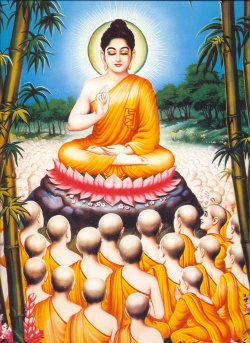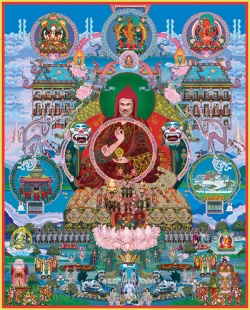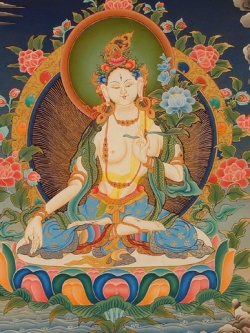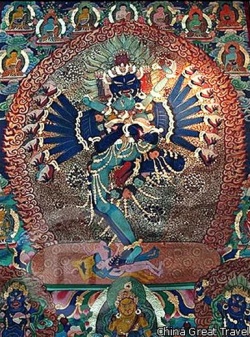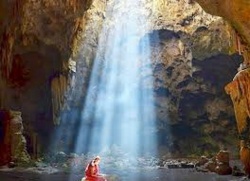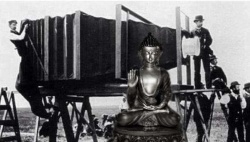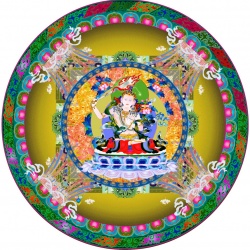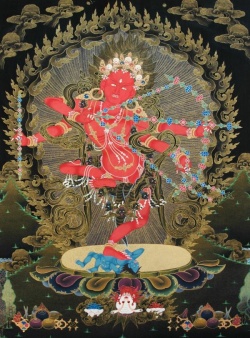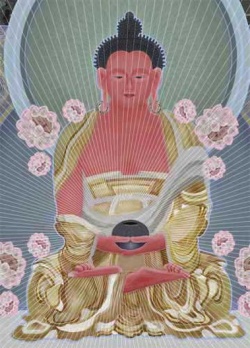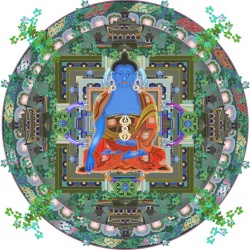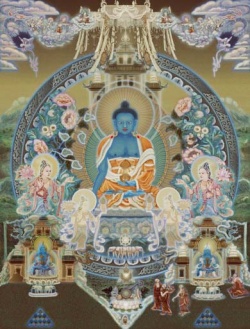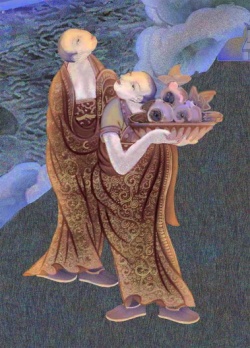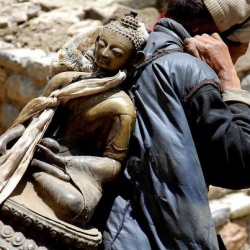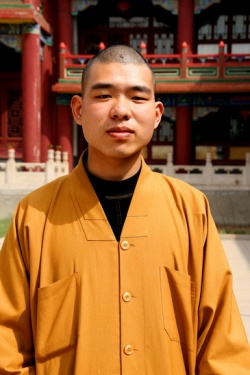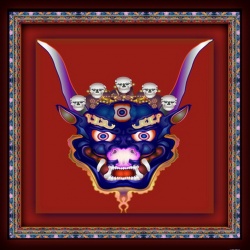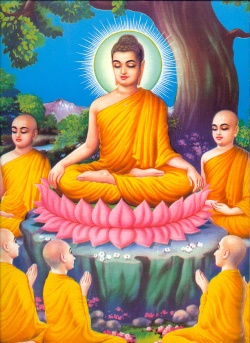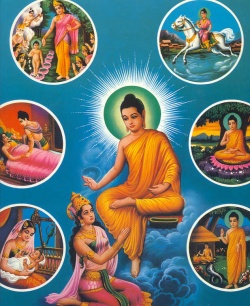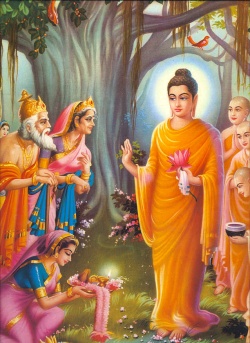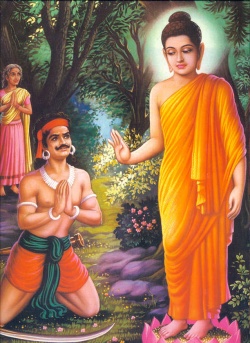Emptiness
Emptiness (Skt. śūnyatā; Tib. སྟོང་པོ་ཉིད་, tongpa nyi; Wyl. stong pa nyid) — the absence of inherent existence in all phenomena, which was explained by the Buddha in the sutras of the second turning of the Wheel of Dharma, and further elaborated upon by masters such as Nagarjuna and Chandrakirti. emptiness (shunyata, kongxing, tong pa nyi): Lack of inherent existence of one’s own nature or the nature of any phenomena or person. The six great elements are intrinsically empty. They are not real. The past, present, and future cannot be held or possessed. Hence, the elements are empty. What happened in the past is not real since it has already passed. The present is also false because as soon as it appears, it becomes the past. The future has not even come yet, so it, too, is empty. See also “three entities.”
Sogyal Rinpoche says:
- "Unfortunately, the word ‘emptiness’, which is used to translate the Sanskrit term shunyata, carries a connotation of a nothing-ness, or a void. Happily, there is a wonderful definition in Tibetan that captures its true meaning: Tib. རྟག་ཆད་དང་བྲལ་བ་, tak ché dang dralwa, which translates as: ‘free from permanence and non-existence'.
- Generally, all philosophies tend to fall into one of two extremes: ‘eternalism‘: believing in the existence or permanence of something, or ‘nihilism‘: believing in non-existence. Shunyata goes beyond both of these extremes, because it is neither permanent nor non-existing, and that is, ultimately, how things are."
The Analogy with Space
Shunyata is often compared to space, which is defined in Buddhism as the complete openness, or 'unobstructedness', which allows anything to occur. Likewise, because reality is 'empty' and not fixed in any way, it is said that anything is possible. As Nagarjuna said:
- To whomever emptiness is possible,
- All things are possible.
Subdivisions
The Emptiness of Emptiness
Nagarjuna does not put forward emptiness as another view about reality. In fact, he says:
- The victorious ones say that emptiness
- Undermines all dogmatic views,
- Those who take a dogmatic view of emptiness
- Are said to be incurable.
And:
- I prostrate to Gautama,
- Who, out of compassion,
- Taught the sacred Dharma
- That leads to the relinquishing of all views
Alternative Translations
- great emptiness
- voidness—an absence of an impossible way of existing (Alexander Berzin).
Oral Teachings Given to the Rigpa Sanhga
Edited Teachings of Sogyal Rinpoche
- Rigpalink January 2010, 'The View of Shunyata - part 2', Lerab Ling, 26 September 2008; Barcelona 10 & 11 October 2009 (available in English, French, German and Spanish, ordernumber 731)
- Rigpalink December 2009, 'The View of Shunyata - part 1', Lerab Ling, 13 August 2009; Barcelona, 10 October 2009 (available in English, French, German and Spanish, ordernumber 730)
- Rigpalink June 2000, 'Shunyata – The Nature of Reality', Paris, 19 April 2000 (available in English, French, German, ordernumber 321)
Further Reading
- A Treasury of Dharma, aka The Mengak Study Pack (Lodève: The Tertön Sogyal Trust, 2005), pages 68-74.
- Khenpo Tsultrim Gyamtso Rinpoche, Progressive Stages of Meditation on Emptiness (Auckland: Zhyisil Chokyi Ghatsal Publications, 2001).
- Thinley Norbu, The Small Golden Key (Shambhala Publications, 1999), ‘7. Great Emptiness'.
Sunyata (Sanskrit) and Sunnata (Pali) translates as “emptiness” in English.
It is a basic concept in Buddhism and is stressed especially in some schools of Mahayana Buddhism, including Zen.
Emptiness teaches the lack of substantiality or independence of things, and stresses the idea of no independent origination, that the present state of all things is the result of a previous state.
Emptiness includes the teaching of impermanence; everything is always in a state of change.
In other words, everything, including every sentient being, is an ever-changing process.
The dharma of non-attachment relates to the concept of emptiness and impermanence, since if all things are impermanent and are always changing, what is there to be attached to? Being free of attachments is the true state of emptiness.
The Buddha taught that this is like this, because that is like that . . . and that is like that, because this is like this; this is called dependent co-arising.” Empty Image
“It is not the river that flows, the flow is the river; and there is no riverbed – the flow is therefore empty.”
“You can’t step into the same river twice. Why? Because you and the river are constantly changing.
The river does not stay the same and neither do you.”
“Where is the baby in your baby picture?”
His Holiness the Dalai Lama refers to sunyata as “the knowledge of the ultimate reality of all objects, material and phenomenal.” Sunyata explains that everything is interrelated, interdependent and is without substance or soul.
Sunyata or emptiness does not mean that there is no existence of matter.
It does not mean that there is no existence of feelings, perceptions or ideas.
The five aggregates that comprise a sentient being, i.e. body, feelings, perceptions, mind formations or thought process, and consciousness, are impermanent, ever-changing and therefore empty.
Forms or material things are compounded, the result of something else, the effect of a cause, and are therefore impermanent and empty.
Each of us is made of stardust, and even the stars are the result of something else.
Can you imagine there being a beginning of anything and there being an ending? Name something that was not the result of something else and the cause of something else.
How far back can we go in naming our ancestors?
The human brain has a difficult time coping with the idea that there either is a beginning and an end, or that there is not.
The reason for the Buddhist teaching of emptiness is to loosen all attachments to views, stories and assumptions, leaving the mind empty of all greed, anger, and delusion; therefore empty of suffering of stress, anxiety, frustration and unsatisfactoriness.
Emptiness is a key concept in Buddhist Philosophy, or more precisely, in the ontology of Mahayana Buddhism.
The phrase "Form is emptiness; emptiness is Form" is perhaps the most celebrated paradox associated with Buddhist philosophy.
It is the supreme Mantra. The expression originates from the Prajna Paramita Hridaya Sutra, commonly known as The Heart Sutra, which contains the philosophical essence of about six hundred scrolls making up the Maha Prajna Paramita.
The Heart Sutra is the shortest text in this collection. It belongs to the oldest Mahayana texts and presumably originated in India around the time of Jesus Christ.
The Heart Sutra.
Translation by Edward Conze
Homage to the Perfection of Wisdom, the Lovely, the Holy!
Avalokita, The Holy Lord and Bodhisattva, was moving in the deep course of the Wisdom which has gone beyond.
He looked down from on high, He beheld but five heaps, and he saw that in their own-being they were empty.
Here, Sariputra, Form is emptiness and the very emptiness is Form; emptiness does not differ from Form, Form does not differ from emptiness; whatever is Form, that is emptiness, whatever is emptiness, that is Form, the same is true of feelings, perceptions, impulses and Consciousness.
Here, Sariputra, all dharmas are marked with emptiness; they are not produced or stopped, not defiled or immaculate, not deficient or complete.
Therefore, Sariputra, in emptiness there is no Form, nor Feeling, nor Perception, nor impulse, nor Consciousness; No Eye, ear, nose, tongue, Body, Mind; No forms, sounds, smells, tastes, touchables or objects of Mind; No sight-organ element, and so forth, until we come to: No Mind-Consciousness element;
There is no Ignorance, no extinction of Ignorance, and so forth, until we come to: there is no decay and Death, no extinction of decay and Death.
There is no Suffering, no origination, no stopping, no Path. There is no cognition, no attainment and non-attainment.
Therefore, Sariputra, it is because of his non-attainment that a Bodhisattva, through having relied on the Perfection of Wisdom, dwells without Thought-coverings. In the absence of Thought-coverings he has not been made to tremble, he has overcome what can upset, and in the end he attains to Nirvana.
All those who appear as Buddhas in the three periods of time fully awake to the utmost, right and perfect Enlightenment because they have relied on the Perfection of Wisdom.Therefore one should know the Prajnaparamita as the great spell, the spell of great Knowledge, the utmost spell, the unequalled spell, allayer of all Suffering, in Truth - for what could go wrong? By the Prajnaparamita has this spell been delivered. It runs like this:
Gone, gone, gone beyond, gone altogether beyond, O what an Awakening, all-hail!
Translations and commentary.
Avalokita = Avalokiteshvara, the Bodhisattva of Compassion
Sariputra = Disciple of The Buddha
paramita = that which has reached the other shore
Prajnaparamita = Wisdom acquired experientially, by means of intuitive Insight, and perfected through cultivation to the level of transcendental Knowledge
According to Buddhist scholars, the dialogue between Avalokiteshvara and Sariputra is inspired by The Buddha.
This is to say it occurs spontaneously without the speaker's intention. The content of the conversation is determined entirely by the Power of The Buddha's Concentration.
The Bodhisattva Avalokiteshvara represents the idea of perfect universal Wisdom, while Sariputra is regarded as one of The Buddha's closest and brightest disciples. The dialogue takes place at the Vulture Peak near the ancient city of Rajgaya where The Buddha and his community of Monks stayed. Sariputra requests Avalokiteshvara to instruct him on the practice of the perfection of Wisdom, which means Prajnaparamita in Sanskrit.
The perfection of Wisdom refers to the Wisdom that directly and intuitively understands the ultimate nature of Phenomena.
Sariputra answers with the pr ofound words,
and proceeds to state the emptiness of The five aggregates (Skandhas), the emptiness of the teachings (dharmas), and the emptiness of all Phenomena.
The Sutra ends with the celebrated Mantra "gate gate paragate parasamgate Bodhi svaha" which can be translated with "Homage to the Awakened Mind which has gone over to the other shore."
The one who has gone over means: the Enlightened one, who has done away with views, ideas, and perceptions and who looks upon reality without any obstructions of Mind.
What is emptiness
The Buddhist notion of emptiness is often misunderstood as nihilism.
Unfortunately, 19th century Western philosophy has contributed much to this misconstruction.
Meanwhile Western scholars have acquired enough Knowledge About Buddhism to realise that this view is far from accurate.
The only thing that nihilism and the teaching of emptiness can be said to have in common is a sceptical outset.
While nihilism concludes that reality is unknowable, that nothing exists, that nothing meaningful can be communicated about the World, the Buddhist notion of emptiness arrives at just the opposite, namely that ultimate reality is knowable, that there is a clear-cut ontological basis for Phenomena, and that we can communicate and derive useful Knowledge from it about the World.
Emptiness (Sunyata) must not be confused with nothingness. Emptiness is not non-existence and it is not non-reality.
What is emptiness then?
To understand the philosophical meaning of this term, let's look at a simple solid object, such as a cup.
How is a cup empty? We usually say that a cup is empty if it does not contain any liquid or solid.
This is the ordinary meaning of emptiness.
But, is the cup really empty? A cup empty of liquids or solids is still full of air.
To be precise, we must therefore state what the cup is empty of.
Can a cup be empty of all substance? A cup in a vacuum does not contain any air, but it still contains space, Light, radiation, as well as its own substance.
Hence, from a physical point of view, the cup is always full of something.
Yet, from the Buddhist point of view, the cup is always empty.
The Buddhist understanding of emptiness is different from the physical meaning.
The cup being empty means that it is devoid of inherent existence.
What is meant with non-inherent existence? Is this to say that the cup does not ultimately exist? - Not quite. - The cup exists, but like everything in this World, its existence depends on other Phenomena.
There is nothing in a cup that is inherent to that specific cup or to cups in general.
Properties such as being hollow, spherical, cylindrical, or leak-proof are not intrinsic to cups.
Other objects which are not cups have similar properties, as for example vases and glasses.
The cup's properties and components are neither cups themselves nor do they imply cupness on their own.
The material is not the cup.
The shape is not the cup. The function is not the cup.
Only all these aspects together make up the cup.
Hence, we can say that for an object to be a cup we require a collection of specific conditions to exist. It depends on the combination of function, use, shape, base material, and the cup's other aspects.
Only if all these conditions exist simultaneously does the Mind impute cupness to the object.
If one condition ceases to exist, for instance, if the cup's shape is altered by breaking it, the cup forfeits some or all of its cupness, because the object's function, its shape, as well as the imputation of cupness through Perception is disrupted.
The cup's existence thus depends on external circumstances.
Its physical essence remains elusive.
Those readers who are familiar with the theory of ideas of the Greek Philosopher Plato will notice that this is pretty much the antithesis to Plato's idealism.
Plato holds that there is an ideal essence of everything, e.g. cups, tables, houses, humans, and so on.
Perhaps we can give Plato some credit by assuming that the essence of cups ultimately exists in the realm of Mind.
After all, it is the Mind that perceives properties of an object and imputes cupness onto one object and tableness onto another.
It is the Mind that thinks "cup" and "table". Does it follow that the Mind is responsible for the existence of these objects? -
Apparently, the Mind does not perceive cups and tables if there is no visual and tactile sensation.
And, there cannot be visual and tactile sensation if there is no physical object.
The Perception thus depends on the presence of sensations, which in turn relies on the presence of the physical object.
This is to say that the cup's essence is not in the Mind.
It is neither to be found in the physical object. Obviously, its essence is neither physical nor Mental.
It cannot be found in the World, not in the Mind, and certainly not in any heavenly realm, as Plato imagined.
We must conclude that the objects of Perception have therefore no inherent existence.
If this is the case for a simple object, such as a cup, then it must also apply to compound things, such as cars, houses, machines, etc.
A car, for example, needs a motor, wheels, axles, gears, and many other things to work. Perhaps we should consider the difference between man-made objects, such as cups, and natural Phenomena, such as Earth, plants, Animals, and human beings. One may argue that lack of inherent existence of objects does not imply the same for natural Phenomena and beings.
In case of a human being, there is a Body, a Mind, a character, a history of actions, habits, behaviour, and other things we can draw upon to describe a person. We can even divide these characteristics further into more fundamental properties.
For example, we can analyse the Mind and see that there are sensations, cognition, feelings, ideas.
Or, we can analyse the brain and find that there are neurons, axons, synapses, and neurotransmitters.
However, none of these constituents describe the essence of the person, the Mind, or the brain. Again, the essence remains elusive.
Emptiness of the Five Skandhas
The Heart Sutra expresses the same idea by stating the emptiness of the Five Skandhas, i.e. the emptiness of the Body, sensations, perceptions, Mental formations, and Consciousness.
The Five Skandhas are commonly translated into English as The five aggregates.
According to The Buddha, these Aggregates are what constitutes a person.
As adumbrated above, it is possible to deconstruct the Five Skandhas in the same manner as objects.
However, this method of deconstruction assumes a third person perspective.
It analyses Phenomena perceived as external to the observer.
When we talk about the essence of a person, the situation is slightly different, because we talk indirectly about ourselves.
It may therefore be more intuitive to look at things from a first person perspective.
The first person perspective allows us to make statements about the internal state of the observer thereby producing self-reference.
What is observed is the observer.
Perhaps this will lead to new insights into the essence of Mind and Body.
First, let's look at experience.
What exactly is experience? - Obviously, we experience objects and Phenomena through the senses.
This is one Form of experience.
We also experience feelings, moods, thoughts, and emotions.
The former can be called sensory experiences and the latter Mental experiences.
Upon contemplating the distinction we may find that there is no clear boundary between sensory and Mental experience.
As soon as we perceive a physical object, for example an apple, the corresponding Mental experiences are immediately triggered.
First, we think "apple".
This is identification.
Following this Thought, a number of things we associate with apples may come to Mind, for example "sweet, edible, green, red, healthy, delicious, juicy," and so on.
These associations may be followed by the build-up of a Desire to touch or to taste the apple.
Once the Desire is strong enough, our thoughts may be occupied with consuming the apple and we start weighing the merits and demerits of consuming the apple now or later.
All these Mental experiences are caused by, yet independent of the original object.
If the apple is withdrawn, the memory of it may be able to sustain the chain of thoughts for a short time, yet it will eventually cease.
We can infer that Mental experience requires sensory experience, or respectively memory of sensory experience. Sensory experience in turn requires the Body.
If we carried through a Thought experiment and examined whether each of the Skandhas is able to exist without the other four, we would find that this is not possible.
The latter four Aggregates all depend on the Body.
Without the brain and the nervous system there is no Consciousness, no sensation, no Perception, and no Mental formations. On the other hand, we cannot imagine the Body to function without the Mind.
The Body and the Mind depend on each other, the Five Skandhas depend on each other.
We must conclude that none of the Skandhas is fundamental.
Body, sensations, perceptions, Mental formations, and Consciousness are interrelated.
Experiences emerge from the interaction of all Five Skandhas. Just as objects, experiences are conditioned by the interplay of multiple Phenomena. Experience has no inherent existence either.
Our brain is advanced enough to reflect on its experiences.
By means of self-reference we can direct Mental activity onto itself.
For example, we can think about Thought. From this arises a division between subject, percept, and object.
The percept is the Mental impression, the subject is the owner of it, the thinker, and the object is that which causes the Mental impression. This threefold division seems so natural to us that it is reflected in the grammar of most human languages.
We perceive the separation of subject, percept, and object as real, because Mind attributes an owner to experience and Thought.
This owner is the "self", the subject, the centre of Consciousness, the supposed psychological entity.
Surprisingly, this entity remains completely undetectable.
Body, Feeling, Perception, and Mental formations are not the self. Consciousness is not the self either, otherwise it would follow that the self temporarily ceases to exist during Unconscious states, for example during deep sleep.
We might ask how "self" can be independent of a surrounding World.
Is it possible for the self to exist in a Mental vacuum, a World devoid of sense impressions, Thought, and Mental images? Would the self not literally run out of fuel if it lacked thoughts and contents to identify itself with or to set itself apart from? It seems there is no basis an independent entity.
It seems more that the self is an emergent Phenomenon arising from the application of complex interpretative schemes to Perception.
In particular, it arises from the conceptual division between subject, object, and percept.
Through introspection it is possible to realise that the "self" is not fundamental.
It is created by the Mind through identification and discernment. The "self" is itself a Mental formation - a product of Mind. It is therefore empty of inherent existence.
The emptiness of matter
The ancient Greeks believed that matter is composed of indivisible small elements with certain characteristics, such as the characteristics of Earth, water, air, and Fire. They called these elements atoms and they held that atoms were solid and fundamental, like microscopic billiard balls.
Ernest Rutherford invalidated the billiard ball theory by conducting an experiment, which suggested that atoms have an internal structure.
He established that atoms have a nucleus containing most of its mass and that electrons orbit the nucleus.
Moreover, he established that the nucleus of an atom is only about one ten-thousandth of the diameter of the atom itself, which means that 99.99% of the atom's volume consists of empty space.
This is the first manifestation of emptiness at the subtle level of matter.
Not long after Rutherford's discovery, physicists found out that the nucleus of an atom likewise has an internal structure and that the protons and neutrons making up the nucleus are composed of even smaller particles, which they named quarks after a poem of James Joyce.
Interestingly, quarks are hypothesised as geometrical points in space, which implies that atoms are essentially empty.
This is the second manifestation of emptiness at the subtle level of matter.
The terms "quarks" and "points in space" still suggest something solid, since they can be imagined as irreducible mass particles.
Yet, quantum field theory does away even with this finer concept of solidity by explaining particles in the terms of field properties.
Quantum electrodynamics (QED) has produced an amazingly successful theory of matter by combining quantum theory, classical field theory, and relativity.
No discrepancies between the predictions of QED and experimental observation have ever been found. According to QED, subatomic particles are indistinguishable from fields, whereas fields are basically properties of space.
In this view, a particle is a temporary local densification of a field, which is conditioned by the properties of the surrounding space.
Ergo, matter is not different from space.
This is the third manifestation of emptiness at the subtle level of matter.
An important class of Phenomena in the subatomic World is defined by the various interactions between particles.
In fact, there is no clear distinction between the notions of Phenomena, particles, and interactions, although interactions can be described clearly in mathematical terms.
For example, there are interactions between free electrons by means of photons that result in an observed repelling force.
There are also interactions between the quarks of a nucleon by means of mesons, interactions between the neighbouring neutrons or protons, interactions between nucleus and electrons, and interactions between the atoms of molecules.
The Phenomena themselves -the nucleon, the nucleus, the atom, the molecule- are sufficiently described by these interactions, meaning by the respective equations, which implies that interactions and Phenomena are interchangeable terms. Interestingly, the interrelations of quantum physics do not describe actual existence.
Instead they predict the potential for existence.
A manifest particle, such as an electron, cannot be described in terms of classical mechanics.
It exists as a multitude of superposed "scenarios", of which one or another manifests only when it is observed, i.e. upon measurement.
Therefore, matter does not inherently exist. It exists only as interrelations of "empty" Phenomena whose properties are determined by observation.
This is the fourth manifestation of emptiness at the subtle level of matter.
Emptiness in mathematics
In mathematics the notion of emptiness finds expression in the number zero, as well as in contemporary set theory.
The concept of zero was discovered in India prior to the sixth century A.D. The "Arabic" number system we use today is neither Arabic nor Greek in origin. In fact, the digits 0123456789 go back to India where they were first created.
The ancient Indian number system distinguished itself from other positional systems by Virtue of allowing the use of zero as a legitimate number.
Interestingly, the number zero did not exist in Greek mathematics, because the Greeks were essentially geometricians and had no use for the mathematical concept of a non-entity, neither did it exist in Egyptian mathematics.
The Arabs, who encountered the Indian number system during their early conquests in India, found it superior to their own traditional system which used letters, and thus adapted it to develop Islamic mathematics.
The Arabic word for zero is "sifr", meaning "empty." In the 12th century, the Italian mathematician Leonardo Pisano Fibonacci studied Arabian algebra and introduced the Hindu-Arabic numerals to Europe.
The word "sifr" thus became "zephirum" in Latin and "zero" in English.
In the ancient Indian context, the number zero did not originally refer to nothingness or nullity.
The Sanskrit word for zero is shunya, which means "puffed up, hollow, empty." The zero stands for emptiness suggestive of potentiality.
The discovery of the mathematical zero concurred with the emptiness of Prajna-intuition in India around 200 BC. Both signify polar opposition between being and nonbeing.
Zero is that which contains all possible polarised pairs such as (+1, -1), (+2, -2), etc. It is the collection of all mutually cancelling pairs of forward and backward movements.
Put it another way, zero is fundamental to all existence. Because of it, everything is possible.
Zero is the additive identity, the focal point of all numbers; without it, numbers cannot be created.
India alone, among the great civilisations of antiquity, was able to fathom the depth of emptiness and willing to accept its consequences in mathematics.
Following the introduction of the Hindu-Arabic numerals into Western culture, zero became a number that was used in calculations like any other number. Consequently, it lost some part of its original meaning, namely the part that suggests potentiality.
Today, most mathematicians do not associate the notion of emptiness with zero, but with the empty set, which is a construct of set theory.
A set is a collection of objects or numbers. For example, the set { 1, 2, 3, 5, 8 } is a set of numbers containing five elements; it is therefore said to have the "cardinality" of 5. The empty se
is a collection that contains nothing and has the cardinality 0. The mathematician John von Neumann (1923) invented a method, known as von Neumann hierarchy, which can be employed to generate the natural numbers from the empty set as follows:
This sequence is obtained by iterating a functor that creates a new set from the union of the preceding two sets, thus generating sets with the cardinalities 0, 1, 2, 3, 4, ad infinitum.
In less mathematical terms, the principle can be described as follows: beginning with emptiness (step 0), we observe emptiness.
Through the act of observing we create an entity containing emptiness (step 1).
Now we perceive emptiness, as well as an entity.
From the combination of the former two we create another entity by observation, which is different from the first entity (step 2). This process is repeated again and again.
Interestingly, if we define suitable operations on the obtained sets based on union and intersection, the cardinalities of the resulting sets behave just like natural numbers being added and subtracted. The sequence is therefore isomorphic to the natural numbers - a stunningly beautiful example of something from nothing.
Emptiness of emptiness
In The Art of Living (2001) the 14th Dalai Lama says, "As your Insight into the ultimate nature of reality is deepened and enhanced, you will develop a Perception of reality from which you will perceive Phenomena and events as sort of illusory, Illusion-like, and this mode of perceiving reality will permeate all your interactions with reality. [...] Even emptiness itself, which is seen as the ultimate nature of reality, is not absolute, nor does it exist independently.
We cannot conceive of emptiness as independent of a basis of Phenomena, because when we examine the nature of reality, we find that it is empty of inherent existence.
Then if we are to take that emptiness itself is an object and look for its essence, again we will find that it is empty of inherent existence. Therefore The Buddha taught the emptiness of emptiness."
It is crucial to understand that the term, Emptiness, does not mean Nothing.
Saraha: "The root of everything in existence and beyond is, oh yes it is, it is Mind"
Maitripa: "All phenomena are one's own mind.
Seeing external objects is the deluded mind.
They are empty of essence, like a dream."
Orgyenpa: "All phenomena are like reflections.
To think that they are real is missing the point
All of existence is mind's dance and play
To turn it into objects is uncool
Every single thing is a magic illusion
To think there's something there is being a fool!"
Alan Wallace: ". . . phenomena are dreamlike; there is no substantial reality that accords with appearances. We observe phenomena as being far more concrete and tangible than in fact they are, and this is misleading. It occurs because of the mental process of reification.
Sechibuwa explains that there is no entity apart from the mind that is anything more than a deceptive appearance to the mind. Nothing exists independently of consciousness or mental designation. "
How it is that we get the impression the world and everything in (and outside it) is Real is debatable, however. There are a number of interesting and convincing Buddhist philosophical views. They can be classified into four main categories: Vaibhasika, Sautrantika, Yogachara, and Madhyamika. One System, Four Stages
In a rimay or ecumenical spirit, there is a tendency to view these 4 rather distinct views as one system with four stages.
That is because, as Todd Fenner says, "the definition of 'selflessness' becomes subtler and subtler and so the schools serve as a bridge or a ladder.
The notion of doing it this way is reinforced by the Hevajra Tantra which explicitly advises one to progress in this fashion."
If we entertain that idea, then 1 and 2 below correspond to the Hinayana, and 3 and 4 to the Mahayana.
1. Vaibhasika has been called "direct realism."
It is similar to the first few of the Indian views that see the World of Experience as composed of various physical elements that interact with the components of beings.
2. Sautrantika considers that awareness is merely representational.
These first two schools consider that there are two kinds of interactors: Physical aspects, ie. skandhas of which one, rupa comprises the traditional elements, and the Mental aspects including consciousness (vijnana), sensation (vedana) which contributes to pain/pleasure, cognition (sanjna) and the impressions derived from experience
(samskara.) See the 12 Links of Causality.
Chittamatra is often given as the 3rd, and a variant of it is:
3. Yogachara [older spelling: yogacara) sometimes referred to as the Knowledge Way or Vijnanavada.
It has also been called Subjective Realism, acknowledging that individual factors including karma contribute to an experience of reality that must be different for everyone. It mentions the idea of "Buddha nature." Vasubandhu and Asanga finally adopted this position.
4. Madhyamika basically holds that there is no ultimate reality in the sense that something exists apart from the experiencer, but that does not mean there is nothing at all. It turns around the definition of Shunyata and therefore has been called Sunyatavada or "voidism."
Nagarjuna and Aryadeva are the main proponents. Chandrakirti expounds upon Nagarjuna.
Sometimes people do not see the views as organized in that distinct way.
For example, Prasangika, Yogacharya and Svatantrika have been considered kinds of Madhyamaka.
In any case, the Madhya- or Middle Approach has given rise to the two main interpretations:
Rangtong (Tibetan for Other-Empty) and
Shentong (or, Zhentong -- Self-Empty.)
Rangtong-ism uses a positive or pragmatic approach, teaching that we can do something, and provides clear step-by-step instructions on how to attain the Objective.
Shentong-ism, which speaks of Buddha-nature, is more concerned with not striving, with dropping or not repeating, so that one's intuition, which is beyond concept and elaboration, can do its work.
Many would say that they are different modes of the same thing but from different perspectives -- different circumstances and usages. Dudjom Rinpoche explained the usage of the two positions like this:
"The Madhyamaka of the Prasangika and the Svatantrika is the coarse, Outer Madhyamaka.
It should indeed be expressed by those who profess well-informed intelligence during debates with extremist Outsiders, during the composition of great treatises, and while establishing texts which concern supreme reasoning.
However, when the subtle, inner Madhyamaka is experientially cultivated, one should meditate on the nature of Yogacara-Madhyamaka."
A Variation on the Classification
Venerable Lama Zopa in Virtue and Reality, IV:
"There are four schools of Buddhist philosophy—Vaibashika (che-tra-mra-wa), Sautrantika (do-de-pa), Cittamatra (sem-tsam) and Madhyamika (u-ma-pa). The fourth of these is the Middle Way school and is divided into two: Svatantrika (rang-gyu-pa) and Prasangika (thal-gyur-wa).
According to the Prasangika school, the object of refutation (or negation, gag-cha) is an extremely subtle object that is ever so slightly more than—a little over and above—what is merely labeled by the mind. The object of refutation is what appears to us; it is that in which we believe. " The Two Truths
Chandrakirti (Tib. Dawa Drakpa) was an early 7th-century disciple of Nagarjuna, who became the abbot of Nalanda University. He explained:
". . . the Transcendent Conqueror presented the two truths with respect to all inner and outer things, like sprouts and everything else.
Genuine truth is described as being simply the authentic object of the noble ones' original wisdom that sees what is authentic and true; there is no identity actually established there for conceptual mind to find.
Relative truth is the false object seen from the perspective of the conceptual mind whose eye of wisdom is completely covered by the cataract of ignorance, as is the case with ordinary beings.
It is therefore posited as being this conceptual mind.
The object perceived does not exist in the way that this mind perceives it to be.
Thus, the Teacher explained that every thing found holds two natures within: a genuine nature and a relative one.
From among these two, the object of the noble ones' authentic vision is the precise nature of reality, genuine truth, and the object of false seeing is relative truth."
~ The Moon of Wisdom: Chapter Six of Chandrakirti's 'Entering the Middle Way' with Commentary from the Eighth Karmapa Mikyo Dorje's 'Chariot of the Dagpo Kagyu Siddhas.' trans. Ari Goldfield, Jules Levinson, Jim Scott & Birgit Scott, guided by Khenpo Tsultrim Gyamtso Rinpoche (Snow Lion Publications, 2006.)
The Truth according to Prasangikas
The 14th Dalai Lama, Tenzin Gyatso Rinpoche in The World of Tibetan Buddhism: An Overview of Its Philosophy and Practice. Boston: Wisdom Pub., 1995. (49-54):
- "According to the explanation of the highest Buddhist philosophical school, Madhyamaka-Prasangika, external phenomena are not mere projections or creations of the mind. External phenomena have a distinct nature, which is different from the mind.
- The meaning of all phenomena being mere labels or designations is that they exist and acquire their identities by means of our denomination or designation of them.
This does not mean that there is no phenomenon apart from the name, imputation, or label, but rather that if we analyze and search objectively for the essence of any phenomenon, it will be un-findable.
Phenomena are unable to withstand such analysis; therefore, they do not exist objectively.
Yet, since they exist, there should be some level of existence; therefore, it is only through our own process of labeling or designation that things are said to exist... .
- For the Prasangikas, if anything exists objectively and is identified within the basis of designation, then that is, in fact, equivalent to saying that it exists autonomously, that it has an independent nature and exists in its own right ... .
- This is a philosophical tenet of the Yogacara school in which external reality is negated, that is, the atomically structured external world is negated.
Because the proponents of the Yogacara philosophical system assert that things cannot exist other than as projections of one's own mind, they also maintain that there is no atomically structured external physical reality independent of mind.
By analyzing along these lines, Yogacara proponents conclude that there is no atomicly structured external reality.
- This conclusion is reached because of not having understood the most subtle level of emptiness as expounded by the Prasangikas.
In fact, Yogacarins assert that things have no inherent existence, and that if you analyze something and do not find any essence, then it does not exist at all.
The 16th-century Bengali scholar, Taranatha (so-named after his devotion to Tara,) was not only a great historian and practitioner who in later life traveled to teach in Mongolia, but was one of the foremost proponents of a view associated with the now absorbed Jonang school of Himalayan Buddhism.
This denomination bridged the Kadampa (or, Gelugpa) and the Kagyupa views.
The former promotes the rang-tong (self-emptiness) doctrine as expounded by Nagarjuna, Chandrakirti, and other Indian teachers.
The latter holds to shen-tong (other-emptiness.)
Shen-tong asserts that Emptiness, "in dispelling the illusive relative truths of the world, reveals an ineffable transcendental reality with positive attributes." Rang-tong holds that Emptiness is "merely the elimination of falsely imagined projections upon the relative truths of the world and does not imply anything else." Stephen Batchelor says further that "While such distinctions may strike us today as theological hairsplitting, in Tibet they became (and still are) crucial articles of faith."
Lama Karma Sherab of the Jamgon Kongtrul labrang (Pullahari, Nepal) insists that it must be emphasized that ultimately there is no difference between the two.
Indian Philosophy: the context for Buddhist views
Nagarjuna
On the originality of Madhyamika philosophy: somewhat technical.
The Gelugpas (or, Kadmapas) maintain this approach.
Buddha Heart, Buddha Mind gives the Dalai Lama's opinion on questions concerning this, the orthodox or Gelugpa (Rangtong) perspective, and related topics.
Shentong or Rangtong?
Object of Refutation: one possible technique for searching for truth is to employ the process of elimination, and see what is left. Therefore, the principle or topic under consideration may be called the object of refutation which helps keep in our mind the notion that the thing is not to be assumed to exist. It is merely a target, so to speak.
Karl Popper (1902-1994) the foremost western philosopher in the field of knowledge was a proponent of this method, especially with regard to scientific research. He held that the more severe the test to which a theory can be subjected, and by means of which it is then either found to be false or to be true, is all-important to the [strength of the] truth discovered.
Jonang: Dolpopa Sherab Gyeltsen (1292-1361) is generally credited with developing the Jonangpa belief system.
like sprouts: Things which are a stage in development on the way to something that may seem to be wholly other. A traditional example, like the mango tree that is huge and bears fruit, but it is the issue of (in a relatively small seemingly-inert nut or seed.
See also: Śūnyatā
